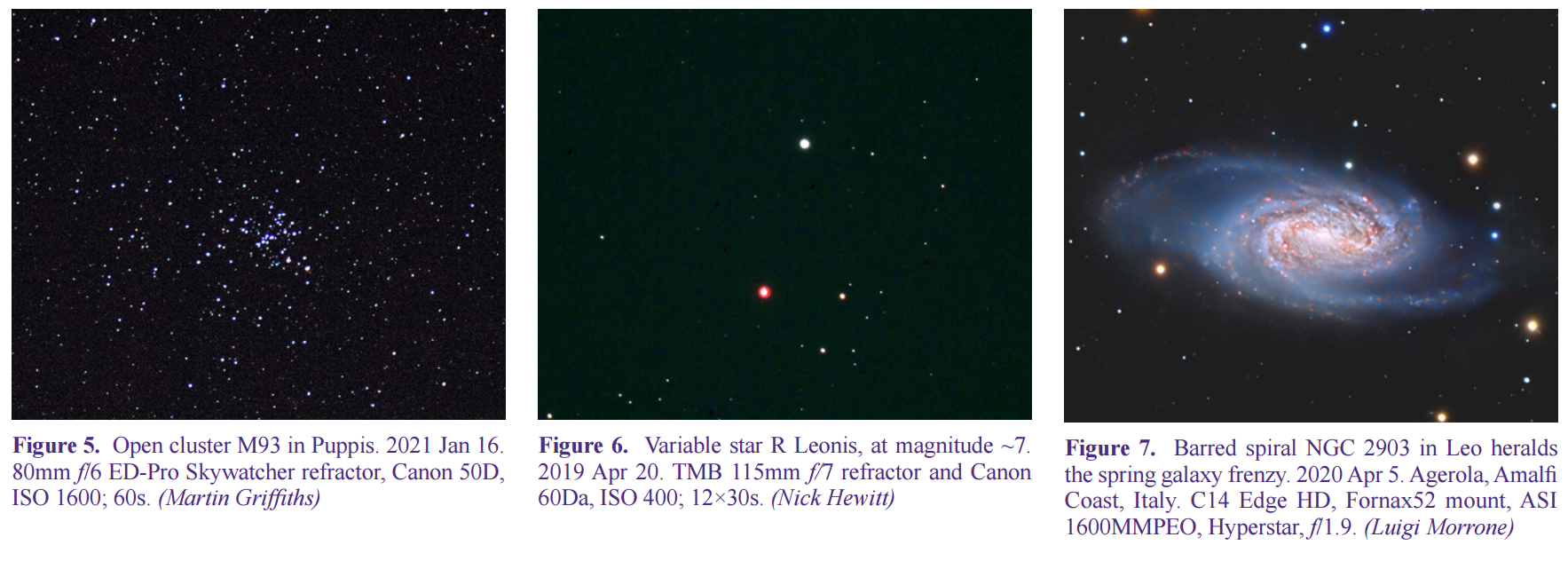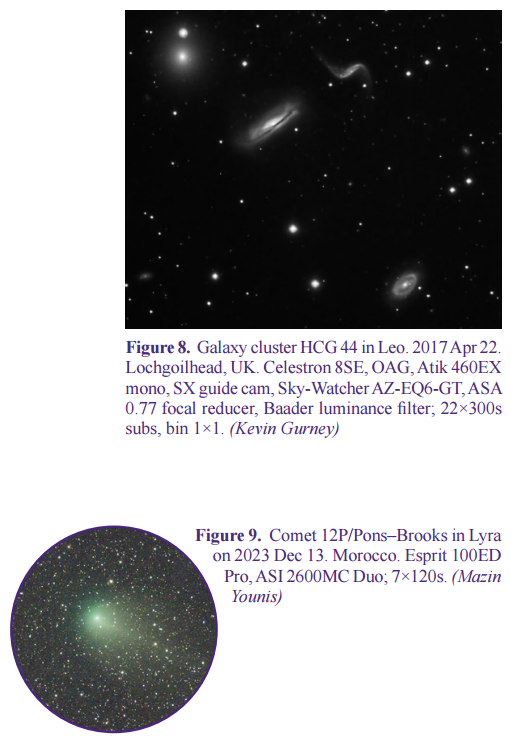Sky notes for 2024 February & March
2024 February 1

February to April sees the winter Milky Way’s embedded glories transition into the depths of the universe. The days draw out as spring enters, with the vernal equinox on Mar 20, followed by British Summer Time commencing on Mar 31. No doubt this causes mixed feelings for astronomers, with shorter but warmer nights. The meridian at 21:00 UT on Mar 1 is an interesting marker for the change of season: to its west lies the Milky Way; to its east we look outwards from our galaxy towards the universe beyond, particularly the local supercluster groups.
This year, the late winter is rather short on planets, with Venus, Mars, Saturn, and the Ice Giants suboptimal or out of view, and even Jupiter is past its best. Mercury provides a fine – if brief – opportunity for observation in March.
In compensation for the dearth of solar-system objects, the deep-sky scene in February is rich in wonders. Orion remains spectacular, and although Taurus begins to drop into the west, Gemini and Auriga remain high, while Monoceros to Orion’s east and the Hunter’s two hounds are best placed. Canis Major is a splendid constellation, rich in open clusters, whilst Canis Minor is not! There is almost nothing of interest within the Little Dog’s boundaries, other than Procyon, its alpha star. This is odd, as this ancient constellation lies on the eastern edge of the winter Milky Way and should have at least a couple of objects to be observed – but no.
Nevertheless, Procyon itself is of interest for the next few years due to the usually challenging possibility of spotting its white-dwarf companion, Procyon B. Procyon A is the eighth-brightest of the fixed stars at magnitude 0.34.

Like Sirius, it owes its brilliance to its relative proximity, at a mere 11.46 light-years away. Due to this, it has a measurable proper motion, which enabled Friedrich Wilhelm Bessel in 1844 to spot a wobble in its path. One is astounded by the precision of his measurements during that era. Bessel postulated there must be a stellar companion but could never observe one. In 1862, Arthur Auwers calculated the orbit of the pair, but again the companion could not be located. Then, in 1896, John Martin Schaeberle spotted it at magnitude 10.7 using the 36-inch Lick refractor on Mount Hamilton. Designated Procyon B, with an orbital semimajor axis of just 4.3 arcsec its proximity to Procyon A makes it a challenging target. The orbital period is 40.84 years and the separation of the pair varies between 8.9–21au, the Sun–Uranus distance. They are currently at maximum separation, although this is a tricky 5.2 arcsec. Good luck!
Procyon is the northeast component of the unofficial Winter Triangle, with Betelgeuse to its west and Sirius at the southern apex. The triangle encompasses much of the best of Monoceros, the unicorn, with its deep-sky riches that include the Christmas Tree Cluster (NGC 2264) with its dark Cone Nebula, the impressive Rosette Nebula (NGC 2244), and Hubble’s Variable Nebula (NGC 2261). We have the BAA’s Variable Star of the Year in the vicinity too. U Monocerotis is a bright example of an RV Tauri star: pulsating yellow giants similar in mass to the Sun, but rather older. U Mon is a good target for binocular or small-telescope observers, as its magnitude range is ~5.5–8.2. The primary period (the interval between deep minima caused by pulsations) is 91 days but there seems to be a secondary long-term variation of 2410 days (around 6.6 years), possibly due to a spectroscopic companion. It lies to the east of a line between Procyon and Sirius, just 2 degrees west of alpha Monocerotis (magnitude 3.9) in a rich starfield. See the Handbook of the BAA for a chart and more details.
Sirius is to the south of Monoceros, and this flashing gem also boasts a white dwarf companion, Sirius B, nicknamed the Pup. The presence of this was also deduced by Bessel, who observed Sirius’s proper motion between 1834 and 1844. The Pup remained undetected until 1862 when Alvan Graham Clark found it at its predicted position while testing his 18.5-inch refractor (now at Dearborn Observatory). It had a visual magnitude of 8.44 and the pair’s orbital period was proven to be 50.1 years. The Pup is very difficult to see or image due to the primary’s brilliance, but the next five years are optimal as the binary separation is ~11 arcsec, 2025 being the best year. It is certainly more feasible than Procyon! The white dwarf is unusually massive, being around a solar mass despite being a similar size to Earth. Even without a search for the Pup, Sirius is a joy to observe as it is relatively low from the UK and our typically unsteady atmosphere causes its brilliant chromatic show (see Figure 1).
If these two white dwarfs are too daunting, a much easier target can be enjoyed to the west of Rigel (beta Orionis). This is the super triple star, 40 (or omicron2) Eridani, a 4th-magnitude group consisting of the three most common stars in the Galaxy: a yellow dwarf, a white dwarf, and a red dwarf. See the 2023 December Sky Notes in the Journal.

Enough of degeneracy! To the northeast of Sirius is the spectacular WR7, an extremely hot Wolf–Rayet star that is trying desperately to lose mass. The hydrogen expelled from the star has generated an intricate emission nebula (NGC 2359 – Thor’s Helmet) with a central bubble and an almost spiral-looking series of arcs due to interaction with the local interstellar medium.

Drifting east lies Puppis, the Poop Deck of the fragmented ship Argo Navis. Although the constellation is low from the UK – in fact, much of it is lost below our horizon – it boasts fine open clusters in its northern aspect including three that Messier included in his catalogue, namely M46, M47, and M93. The former two are a pair within the field of big binoculars, and a lovely sight to enthuse the observer on the bitter February nights.
As winter surrenders to spring, the overall vista changes from galactic to extragalactic, in many ways heralded by the regal lion, Leo. The characteristic sickle is a fine asterism, with first-magnitude Regulus at its base while the leonine body stretches east to Denebola, the ‘tail of the lion’ at magnitude 2.14. While most interest lies in the plethora of galaxies in the region, there are two worthy local stars for the less experienced observer to enjoy. Firstly, northeast of Regulus there is gamma Leonis, or Algieba: a fine binary star embedded in the sickle with an overall magnitude of 2.2. The companion is magnitude 3.5, and despite a separation of just 4 arcsec, the lack of a significant magnitude difference means the pair are easily discerned, both with a warm, yellowish hue. There is also a super red variable star for novices to cut their teeth on. R Leonis is found almost directly west of Regulus and this ruddy gem can be followed using small telescopes. A red giant like Mira, it varies between magnitude 4.3 and 11.6 over 312 days so can be followed with modest telescopes throughout its cycle. It was at minimum in 2023 October and so should be easy in early February, a blood spot on the dark background.

Leo is famous for its galaxies, the Leo Triplet of M65 and M66 with NGC 3628 being a particular favourite. The whole springtime extragalactic scene is heralded by the fine spiral NGC 2903, just west of the sickle asterism. This amuse-bouche heralds the feast of galaxies to follow, as the ‘Realm of the Galaxies’ opens our view of the local universe.
While the spectacular galaxy groups in Leo are popular targets, challenges lurk there too. One is Hickson 44, one of 100 compact galaxy groups compiled by Paul Hickson. This Hickson Compact Group of Galaxies (HCG) has four members, all of which have NGC numbers, suggesting they are easier than most. They are also in an advantageous position, located halfway between Algieba and zeta Leonis. NGC 3190 is an almost edge-on spiral, of magnitude 12.1; NGC 3187 a faint but attractive spiral; NGC 3193 an amorphous 11th magnitude elliptical; and NGC 3185 a small, barred spiral.
Solar system
Sun & Moon
The Vernal Equinox is on Mar 20 and the Sun becomes higher in altitude. Solar maximum of the current Solar Cycle 25 is expected between 2024 January and October. This may create many sunspot groups, flares, and hopefully even more aurorae than in 2023.
Although there are four eclipses in 2024 – two lunar and two solar – the most dramatic will be the total solar eclipse on 2024 Apr 8 that begins in Mexico and crosses the USA. It promises to be one of the best observed eclipses in history, and totality lasts over 4 minutes.
There is a penumbral lunar eclipse on Mar 25, although this will hardly be worth the effort, as no umbral shadow will be seen and maximum eclipse is after moonset. It begins at 04:53 UT.

Planets
This is not a good time for planet enthusiasts, with the outer bodies lying in the Sun’s glare.
Mercury is at superior conjunction on Feb 28 and thus unobservable throughout the month, but it has a favourable showing in mid-March evenings. It reaches greatest eastern elongation on Mar 24 when it is magnitude −0.1 with a 7.7 arcmin crescent.
Venus is very much past its best now, lying very low in the predawn sky although not reaching superior conjunction until June.
Mars emerges into the morning sky but is too low for observation in February. It remains too small (4.1 arcmin) and faint (magnitude 1.2) for satisfactory observation even by the end of March.
Jupiter is still available in the early evenings of February but is lost by the end of March.
Saturn is at conjunction with the Sun on Feb 28 and consequently unavailable in February and March.
Uranus is quite close to Jupiter in the early evenings.
Neptune is in conjunction with the Sun on Mar 17.
Meteors
Late winter is a barren time for meteors, with no well-known showers on offer.

Comets
The interest in the late-winter comets is in their activity rather than their brilliance. It is likely that comet 12P/Pons-Brooks, which underwent marked outbursts in 2023, will be most observed as it brightens in the evenings, although it is rather low. It is at perihelion in April and may be a binocular object in Andromeda at the end of February.
144P/Kushida may brighten as it passes from Pisces into Taurus from February to April.
29P/Schwassmann–Wachmann is always worth a look as it is prone to outbursts and was particularly active during 2023. It will probably be very faint in February and March but is well placed, south of Castor and Pollux.
C/2021 S3 (PanSTARRS) is well placed in Ophiuchus for morning observing enthusiasts in February, rising before dawn.
| The British Astronomical Association supports amateur astronomers around the UK and the rest of the world. Find out more about the BAA or join us. |
